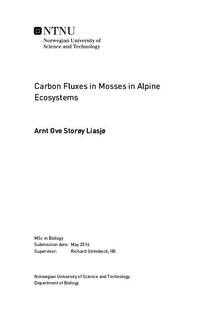Carbon Fluxes in Mosses in Alpine Ecosystems
Abstract
Background and aims Alpines areas expected to see an increase in temperature as a response to climate change and bryophytes are decreasing in coverage compared to vascular plants. Thus it is of interest to see if the photosynthesic activity of mosses are affected by the increase in temperature and if not, it might be that the cause of decrease in bryophyte coverage is a result of competition from shrub plants.Methods Samples of six different species (Aulacomnium palustre, Dicranum sp., Hylocomium splendens, Pleurozium schreberi, Polytrichum commune and Sphagnum sp.) were used in gas exchange measurements at four different temperatures (13, 16, 19 and 22°C). Samples of the six species were also collected and used for measuring of desiccation rate by placing them in an equilibrium chamber and weighing the samples at set time intervals over a period of 24 hours.Results Only Dicranum sp. and Sphagnum sp. showed a statistically significant decrease in net photosynthesic assimilation rate as the temperature increased, though all species show a tendency for decrease up to 19°C. After 19°C Sphagnum sp. stops decreasing and A. palustre and H. splendens shows a slight increase at 22°C. The rest continues to decrease. By comparing the species at the different temperatures, P. commune were found to have the highest assimilation rate at all temperatures and P. schreberi and Sphagnum sp. to have the lowest. For the desiccation rate, there were statistically significant differences in the desiccation rate for the first 30 min, and after that all the six species desiccation rate were more or less the same.Conclusion I have found that as the temperature increases, the differences in Anet between the species decreased indicating that they respond differently to higher temperatures. 19°C seemed to be where the species diverged in response where some continue to have a decrease in Anet, while others stops decreasing or even have an increase as the temperature increases. Sphagnum sp. were found to be the better of the species at retaining water while P. commune were the weakest for the first 30 min.
